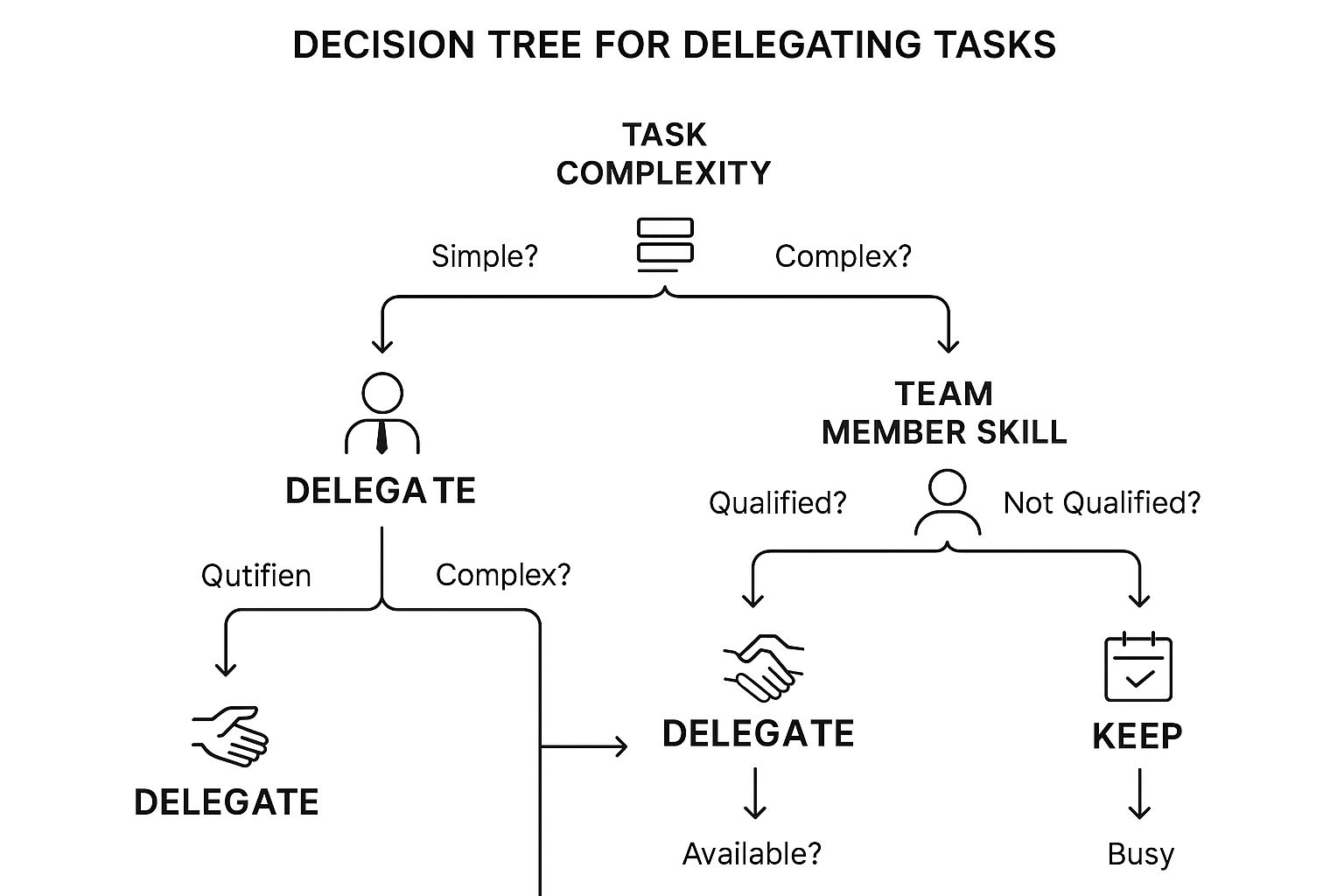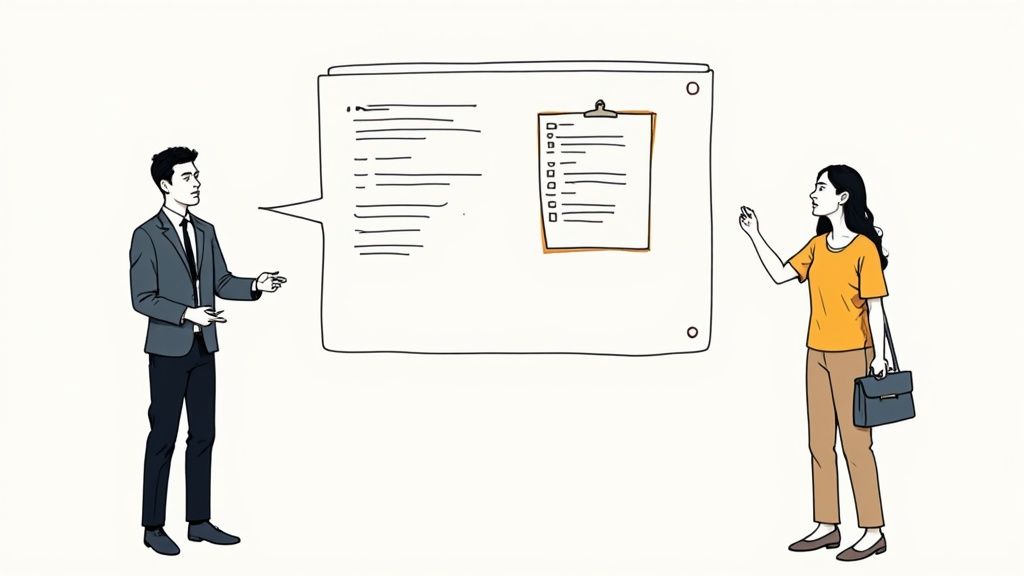Understanding What Effective Delegation Really Means
Effective delegation isn’t about dumping unwanted tasks; it’s a strategic tool for empowering your team and maximizing your impact. Many leaders mistakenly see delegation as a way to shed work they dislike, but true delegation involves strategic empowerment. This requires a fundamental shift in mindset.
The Mindset Shift Behind Effective Delegation
Think of delegation like a relay race. The team’s success depends on each runner’s individual performance and their seamless baton pass. Similarly, effective business delegation hinges on trust, clear communication, and a shared understanding of the goal. This means leaders must transition from being the sole expert to cultivating expertise within their teams.
This often requires overcoming psychological barriers. Many leaders cling to feeling indispensable, fearing a loss of control if they delegate tasks. However, this stifles growth for both the leader and the team. Delegation empowers individuals with specific responsibilities, which goes beyond simple task assignment. It requires trusting team capabilities and prioritizing collective success over personal achievement. Learn more: Understanding Delegation
Recognizing True Delegation
True delegation isn’t just assigning tasks; it’s about giving team members the authority and resources they need to succeed, fostering ownership and accountability. This requires letting go of micromanagement and trusting your team’s capabilities.
For example, instead of dictating every project step, communicate the desired outcome and allow team members autonomy in their approach. This encourages innovation and problem-solving, leading to more engaged and productive employees. It also frees the leader to focus on high-level strategic initiatives.
The Transformative Power of Developing Experts
By shifting from being the expert to developing experts, leaders create a multiplication effect. They empower team members to take ownership and develop their skills, leading to increased productivity and higher quality output. This, in turn, allows the leader to focus on strategic tasks that drive the business forward, creating a cycle of continuous improvement and growth. Ultimately, effective delegation isn’t about offloading work; it’s about building a stronger, more capable, and more resilient team. This approach improves efficiency and fosters a culture of trust, accountability, and shared success.
The Real Business Impact Behind Strategic Delegation

Strategic delegation is more than just clearing your schedule; it’s about actively promoting business growth. It plays a crucial role in driving productivity, fostering innovation, and nurturing employee development, all of which directly impact your bottom line. Understanding effective delegation is essential for leaders building a successful organization.
Delegation as a Growth Engine
Strategic delegation is a powerful engine for growth within any organization. It empowers leaders to concentrate on high-level strategic planning and innovative initiatives while simultaneously enabling team members to hone their skills and assume ownership of their work. This creates a positive cycle, boosting both individual and organizational performance.
For example, delegating project management tasks allows managers to focus on building client relationships or exploring new market opportunities.
Furthermore, entrusting team members with key responsibilities cultivates a culture of trust and accountability. This, in turn, leads to higher employee engagement and job satisfaction, reducing turnover and bolstering overall team performance. This sense of ownership motivates individuals to contribute their best work.
The Measurable Advantages of Strategic Delegation
The benefits of strategic delegation are readily quantifiable. It directly translates to tangible business advantages, such as increased efficiency, improved project completion rates, and a healthier bottom line. These gains arise from ensuring the right people are focused on the right tasks, maximizing individual and collective potential. You might find this resource helpful: How to master strategic planning.
Moreover, studies demonstrate a strong link between effective delegation skills and business growth. A Gallup survey of 143 Inc. 500 CEOs revealed that those who excelled at delegation saw an average three-year growth rate of 1,751%, a remarkable 112 percentage points higher than the average. More detailed statistics are available here. This highlights the importance of delegation as a key differentiator in the current market.
Building a Resilient and Adaptive Organization Through Delegation
Strategic delegation is not just a time management technique; it’s a vital component of building resilient and adaptable organizations. By distributing responsibilities and empowering employees to make decisions, you create a more agile and responsive team. This allows organizations to navigate changes effectively and seize new opportunities.
This decentralized decision-making fosters a proactive and solution-oriented work environment. Team members are encouraged to take ownership of challenges and contribute to innovative solutions. This, in turn, creates a stronger and more adaptable organization capable of thriving in fluctuating market conditions. Additionally, this approach develops future leaders by establishing a pipeline of talent ready to tackle new challenges and ensure sustained success. Through delegation, you accomplish immediate tasks and invest in the long-term health and growth of your organization.
Building Your Delegation Framework That Actually Works
Successfully delegating tasks isn’t about randomly assigning to-dos. It requires a structured approach. This involves pinpointing high-impact tasks, matching them with your team’s skills and career goals, and setting clear expectations without micromanaging. This framework transforms delegation from a guessing game into a powerful leadership tool. You might be interested in: How to master cross-training your employees.
Identifying High-Impact Delegable Tasks
Not all tasks are created equal. Some offer significant returns when delegated, while others are best kept under your direct control. High-impact tasks are those that allow team members to develop new skills, contribute meaningfully to project goals, and free up your time for more strategic activities.
Routine reports, data entry, or first drafts of presentations are great examples of delegable tasks. These allow team members to gain valuable experience while freeing you to focus on client interactions or long-term planning. However, tasks requiring specialized expertise or sensitive information are often best retained by the leader. This careful selection is key to effective delegation.
Matching Tasks to Skill and Growth
Effective delegation goes beyond simply offloading work. It involves aligning tasks with team members’ existing skills and career aspirations. This creates opportunities for growth and boosts the likelihood of successful outcomes. This strategic alignment benefits both the individual and the organization.
Imagine a team member expressing interest in project management. Assigning them the responsibility of organizing a smaller project, even with initial close supervision, offers a practical learning experience. This approach not only completes the task but also cultivates talent within the team, preparing them for larger projects down the line.

This decision tree illustrates the key criteria for effective task delegation: task complexity, team member skill level, and availability. It guides you in deciding whether to delegate or retain tasks based on these three vital factors.
The infographic emphasizes the interconnectedness of these elements. Delegating a complex task to a busy, less experienced team member is a recipe for disaster. Conversely, assigning a simpler task to a qualified and available team member fosters growth and frees up your time.
To further clarify delegation decisions, consider using a decision matrix:
To help you decide which tasks to delegate, retain, or even eliminate, a decision matrix can be a valuable tool. The table below provides a framework for categorizing tasks based on their complexity and strategic importance.
Delegation Decision Matrix: A comparison framework showing which types of tasks should be delegated, retained, or eliminated based on complexity and strategic importance.
| Task Type | Delegate | Retain | Decision Factors |
|---|---|---|---|
| Routine Reports | Yes | No | Low complexity, repeatable process |
| Data Entry | Yes | No | Low complexity, easily learned |
| First Draft of Presentations | Yes | No | Moderate complexity, opportunity for skill development |
| Client Interactions | No | Yes | High complexity, requires leadership experience |
| Strategic Planning | No | Yes | High strategic importance, requires specialized knowledge |
| Initial Project Research | Yes | No | Moderate complexity, good for skill building |
| Final Project Approval | No | Yes | High strategic importance, requires final decision-making authority |
This matrix highlights how tasks like routine reporting and data entry are prime candidates for delegation, while strategic planning and final approvals should be retained by the leader. By considering both complexity and strategic importance, you can make informed choices about how to best allocate your team’s time and resources.
Establishing Clear Expectations and Avoiding Micromanagement
Effective delegation requires clear communication about what you expect. While providing context and desired outcomes is crucial, it’s equally important to avoid micromanaging. Give team members the autonomy to choose their methods, which encourages both ownership and creativity.
This means establishing clear deliverables and deadlines, yet allowing flexibility in how they achieve them. Regular check-ins offer support and address any roadblocks without dictating every step. This balance between guidance and autonomy builds trust and empowers individuals to take true ownership of their work. This balance is the cornerstone of successful delegation.
Mastering Delegation Conversations That Inspire Action

Effective delegation relies on clear communication that inspires action. It’s more than just assigning tasks; it’s about engaging in conversations that truly empower team members. These conversations are essential to unlocking your team’s potential.
The Art of the Delegation Briefing
A successful delegation briefing is a two-way street. Begin by outlining the desired outcome. Paint a clear picture of what success looks like for this specific task. Then, empower your team member.
Instead of dictating the process, encourage a discussion about potential approaches. This fosters a sense of ownership and inspires innovative thinking. When structuring your delegation plan, factor in time project management. This proactive step lays the groundwork for successful completion. Also, explain why the task matters, linking it to the bigger picture of organizational goals. This adds context and motivates.
Establishing Check-In Points and Psychological Safety
Open communication needs to continue beyond the initial briefing. Regular check-ins help keep the project on track without hindering autonomy. These check-ins should be about providing support and clearing roadblocks, not micromanaging.
Creating psychological safety is just as important. Team members need to feel comfortable asking questions or voicing concerns without fear of being judged. This open communication fosters collaboration and turns challenges into learning opportunities. Consider resources like How to master one-on-one meetings to build a culture of trust and continuous improvement.
Handling Pushback Constructively
You may occasionally face resistance during delegation. This can come from various sources, such as feeling overloaded or a lack of confidence. Addressing these concerns constructively is key to successful delegation.
Listen carefully to understand the root of the resistance. Is it unclear instructions, limited resources, or a perceived skills gap? Once you pinpoint the problem, collaborate on a solution. This might involve extra training, adjusted deadlines, or breaking the task into smaller, more manageable pieces. Remember, effective delegation can impact the bottom line. Leaders proficient in delegation see an average 33% higher revenue and reduced employee turnover. They build a culture of trust and accountability. Explore more detailed statistics here.
Real-World Scenarios and Practical Scripts
Delegation conversations are learned best through practice. Consider these scenarios and scripts:
- Scenario 1: Assigning a research report to a junior team member.
- Script: “I want you to lead the research for our upcoming market analysis report. The goal is to identify key trends impacting our industry. Your strong analytical skills make you a perfect fit for this. How do you think you’ll approach this project?”
- Scenario 2: Assigning a client presentation to a senior team member.
- Script: “We have an important client presentation next month. I’d like you to take the lead, given your experience. Success means securing their buy-in for our proposed strategy. What resources will you need to deliver a compelling presentation?”
Mastering these delegation conversations empowers your team, boosts productivity, and drives significant business impact. This approach benefits individual team members and the organization as a whole.
Overcoming The Biggest Delegation Roadblocks

Even with the best framework in place, delegation isn’t always easy. Understanding common roadblocks, and having strategies to address them, is crucial for successful and sustainable delegation. These roadblocks can range from team members resisting new tasks to your own temptation to just do it yourself.
Addressing Team Member Resistance
Team members might resist new responsibilities for a variety of reasons. They could feel overloaded with their current workload, lack confidence in their ability to perform the task, or simply prefer the comfort of familiar routines. Addressing this resistance begins with empathy and open communication. Understanding the individual’s perspective is crucial before offering solutions.
For example, if a team member is overwhelmed, consider adjusting their current workload before adding more to their plate. You may find helpful tips in this article: How to master absence management strategies. If the issue stems from a lack of confidence, providing additional training or pairing them with a mentor can build their skills and self-assurance. Addressing the root of the problem is key to fostering enthusiasm.
Resisting the Urge to Reclaim Tasks
One of the most challenging aspects of delegating is resisting the urge to take back a task when you feel you could do it faster. However, this undermines the entire purpose of delegation, which is to develop team members’ skills and free up your time for strategic work. This requires accepting short-term efficiency sacrifices for long-term gains.
Think of it like teaching someone to ride a bike. Initially, it’s quicker to simply carry the child. But in the long run, letting them learn, even with a few stumbles, is much more beneficial. Similarly, allowing team members to handle a delegated task, even if it takes a bit longer, fosters their professional growth and contributes to your organization’s overall success.
Managing Delegation Anxiety and Maintaining Quality
It’s normal to feel anxious when delegating, especially with critical tasks. However, this shouldn’t stop you from delegating strategically. The key is building trust and establishing a system for maintaining quality without micromanaging. Effective delegation often involves coaching. Resources like this guide on coaching as a manager can help leaders support their team’s development.
This might involve setting clear performance standards, scheduling regular check-ins, and providing constructive feedback. Avoid dictating every step; focus on the desired outcomes and allow team members the autonomy to find their own solutions. This approach promotes both ownership and innovation.
Turning Delegation Failures into Learning Opportunities
Sometimes, even with the best planning, delegated tasks don’t go as planned. Instead of seeing these as setbacks, treat them as valuable learning opportunities. Failure can be a powerful teacher, offering insights into areas for improvement.
Conduct a post-project review with the team member, focusing on identifying the root causes of the failure rather than assigning blame. This open discussion can lead to valuable process improvements, better communication, and clearer expectations for future tasks. This approach transforms a negative experience into a positive step toward continuous improvement. By addressing these roadblocks and adapting your approach, you can make delegation a powerful and sustainable leadership practice.
Your Delegation Implementation Roadmap
Knowledge without action is unrealized potential. This section offers a practical, step-by-step guide to implementing effective delegation. We’ll walk you through assessing your current delegation habits, identifying opportunities for improvement, and creating a realistic timeline to make delegation a regular part of your leadership style. You’ll also discover useful resources, such as delegation tracking systems, communication templates, and criteria for measuring progress.
Assessing Your Current Delegation Habits
Before implementing a new strategy, it’s essential to understand your current approach. Take an honest look at how you delegate tasks now. Do you clearly communicate expectations and desired outcomes, or do you tend to micromanage? Do you empower your team to make decisions, or do they constantly seek your approval? Recognizing your current habits is the first step toward improvement.
Try keeping a delegation journal for a week. Record each delegated task, the instructions you provided, your team member’s response, and the final outcome. This exercise can reveal hidden patterns and areas for improvement in your delegation style.
Identifying Immediate Opportunities for Improvement
After understanding your current delegation habits, pinpoint areas that need immediate attention. Are there tasks you could easily delegate but haven’t? Are any team members ready for increased responsibility? Identifying these quick wins can build momentum and demonstrate the value of effective delegation.
Often, tasks like routine reports, data entry, or creating first drafts are ideal for delegation. These tasks free your time for strategic work while giving your team members valuable experience. For further insights, check out our article on team capacity planning.
Creating a Realistic Delegation Timeline
Developing sustainable delegation habits requires a structured plan. A 90-day implementation plan offers a manageable timeframe for incorporating these principles into your leadership routine. Begin with smaller tasks and gradually increase the complexity and importance of delegated tasks as you and your team gain confidence.
To help visualize this process, the table below, “90-Day Delegation Implementation Plan,” provides a timeline highlighting key milestones, actions, and success metrics for the first 90 days. This plan helps break down the delegation process into manageable phases.
| Week | Focus Area | Key Actions | Success Metrics |
|---|---|---|---|
| 1-4 | Identifying Delegable Tasks | List potential tasks; analyze task complexity and team member skills | Number of tasks identified for delegation |
| 5-8 | Initial Delegation | Delegate low-complexity tasks; provide clear instructions; establish check-in points | Task completion rate; team member feedback |
| 9-12 | Increasing Complexity | Delegate more challenging tasks; empower decision-making; provide support and resources | Quality of work; team member autonomy |
| 13-16 | Refining Communication | Implement effective delegation conversations; address pushback constructively; provide feedback | Clarity of communication; reduced rework |
| 17-20 | Measuring Progress | Track delegated tasks; monitor success metrics; adjust strategy as needed | Improved productivity; team morale |
| 21-24 | Building Sustainability | Incorporate delegation into routine processes; establish accountability; celebrate successes | Consistent delegation practices; team growth |
| 25-28 | Expanding Responsibilities | Delegate larger projects; empower team leadership; provide mentorship | Project success rate; leadership development |
| 29-32 | Continuous Improvement | Review delegation process; gather team feedback; identify areas for refinement | Increased efficiency; team satisfaction |
| 33+ | Maintaining Momentum | Reinforce positive delegation habits; provide ongoing support and development; celebrate achievements | Sustainable delegation practice; high-performing team |
This phased approach allows you to gradually increase the complexity of delegated tasks, building confidence in both yourself and your team members. By tracking success metrics, you can adapt your strategy as needed, ensuring continued improvement.
Maintaining Momentum and Motivation
Initial enthusiasm can wane over time. Implement systems to maintain momentum and motivation. Celebrate both individual and team successes. Recognize and reward team members who demonstrate strong delegation skills. This creates positive reinforcement and encourages continued engagement.
Regularly review and adjust your delegation strategy based on team feedback and performance data. This ensures a continuous improvement cycle and keeps your delegation practices aligned with your team’s evolving needs. For help automating handovers and maintaining workflows during absences, consider our Out of Office Assistant for Jira Cloud.
